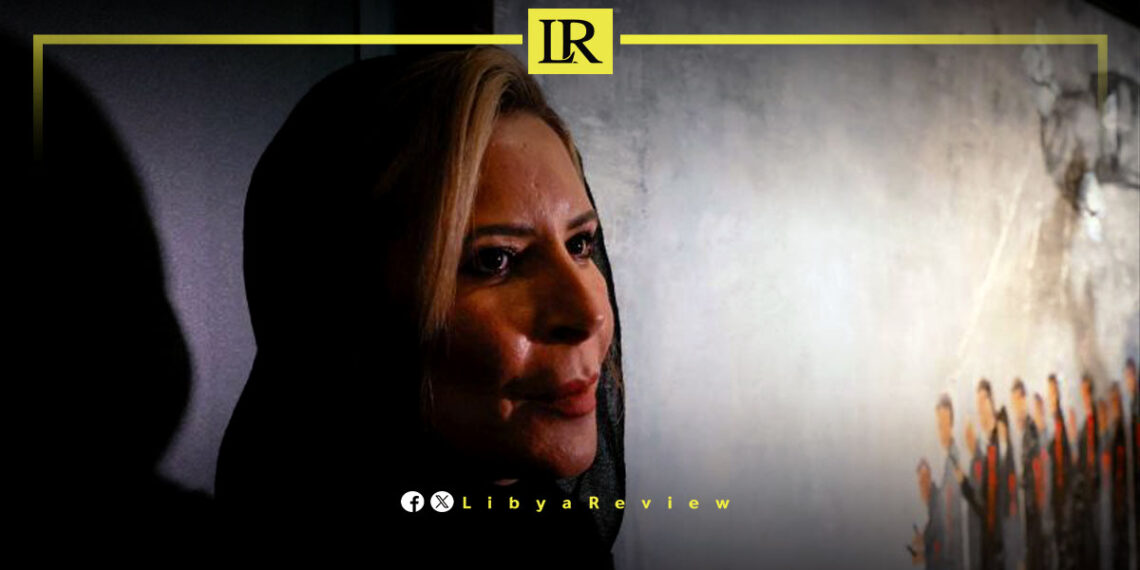On Saturday, a Russian state museum has opened a six-week exhibition showcasing the artwork of Aisha Gaddafi, daughter of Libya’s late leader Muammar Gaddafi, as a tribute to her father and brother, both killed during the 2011 uprising. Held at the State Museum of Oriental Art, the exhibition offers a rare look into Aisha’s personal grief and emotional journey while reflecting on the broader collapse of Libya during the NATO-backed revolution that ended her father’s 42-year rule.
Aisha, 47, is the only biological daughter of Gaddafi, who led Libya from 1969 until his capture and death in 2011. Her brother, Mutassim Gaddafi, was killed alongside him, marking the end of the regime and the beginning of a period of instability that still plagues Libya.
One of the most striking paintings on display depicts a crowd gathered over the lifeless bodies of her father and brother, with onlookers using smartphones to photograph the scene—a haunting commentary on the transformation of personal tragedy into public spectacle. Speaking about the exhibit, Aisha said, “These works are not just painted with my hand but with my heart. They honor the memory of my father and brother on the anniversary of their deaths.”
The Moscow exhibition marks Aisha’s first public appearance in years. Following the fall of her father’s regime, she fled Libya and found asylum in Algeria, where she gave birth to her fourth child. Afterward, she resettled in Oman, where she has lived in exile with little public engagement. The Gaddafi family has said that NATO airstrikes killed her husband and two of her children during the bombing of their Tripoli compound in 2011. These personal losses are deeply woven into her paintings, many of which express themes of mourning, memory, and exile.
The exhibition was organized by Igor Spivak, chairman of the Russian Mideast Society, with support from Russia’s foreign ministry. According to Spivak, Aisha agreed to the exhibition when he proposed the idea during a visit to Oman. “She knows that the people in Russia love her, love her father, and want to see her art,” Spivak told reporters. Russia has long maintained a complicated relationship with the Gaddafi family, with Muammar Gaddafi remembered by many Russians as a leader who resisted Western intervention and aligned himself with countries like Russia in global diplomacy.
Muammar Gaddafi’s rule left an indelible mark on Libya, and his death ushered in a decade of division and conflict. While his regime was known for authoritarianism, some Libyans still recall the period as one of national unity and relative stability. The collapse of his government has led to years of political fragmentation, civil war, and economic hardship. In this context, Aisha’s artwork offers not only a personal reflection but also a commentary on Libya’s continued instability.
The Gaddafi regime shared strong diplomatic and economic ties with Russia, especially in arms deals, energy cooperation, and infrastructure projects. Even after Gaddafi’s fall, Russian public sentiment toward the family remains sympathetic, with many viewing the uprising as a consequence of Western interference. The Moscow exhibition serves not only as a tribute to Aisha’s personal loss but also as a reminder of the long-standing ties between Russia and Libya.
Aisha Gaddafi’s paintings go beyond personal mourning, offering a political statement on the chaos that followed her father’s death. The piece depicting onlookers photographing her father and brother’s bodies captures the tragic intersection of human suffering and public spectacle. Her art offers an intimate glimpse into the aftermath of her family’s fall, confronting the pain of exile, the trauma of war, and the reality of a life disrupted by violence.


